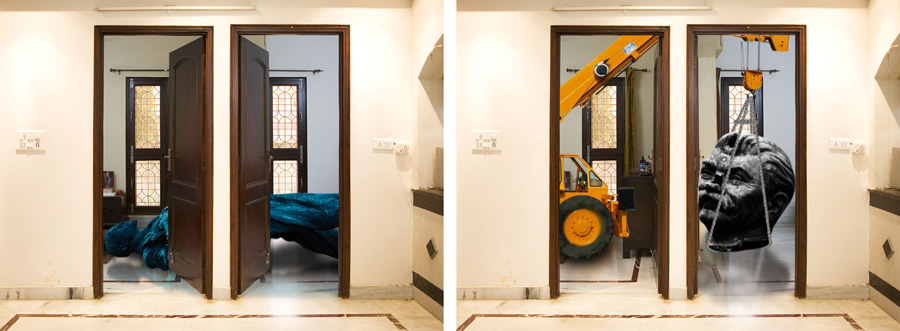G.R. Iranna
Scaffolding the Absent
THE GUILD MUMBAI
November 4 - 22, 2011
Preview: Friday, November 4, 7 pm – 9 pm
Scaffolding the Absent: G.R. Iranna’s Phenomenological Interventions1
“Martin Heidegger pointed out that in every fear there is the recognition of our vulnerability, our mortality, and that anxiety, that feeling of finding ourselves cast adrift, nothing supporting us, nothing to hold on to, is a premonition of what dying will be: a being cast from existence into the void, into nothingness.”2
—Philosopher Alphonso Lingis
The Guild Art Gallery is pleased to present Scaffolding the Absent solo exhibition of G.R. Iranna featuring his most recent body of paintings, with catalogue essay by critic/curator Maya Kóvskaya, PhD. previewing on Friday, November 4, 2011.
In this powerful collection of five new large-scale works, G.R. Iranna meditates on human mortality and the fragility of our existence. “I wanted to create the fragile and slippery ground upon which our life and our existence rest,” explains the artist. Using the figure of the Buddhist monk and Buddhist iconography as a metonym for larger questions, he employs his characteristic visual language in “scaffolding the absent” elements present in our search for an understanding of Being against the backdrop of its incompleteness in our mortal journey. Through his phenomenological visual interventions, Iranna shows how we have failed to articulate a language to explain our origins, our destination and our sense of purpose in the collective solitude of humankind. Even when we are together, we stand alone in tackling these questions that concern each of us and define the nature of our mortality.
While nominally depicting religious symbols, the works are not representations of Buddhism, per se, but rather visual vehicles for exploring deeper human questions alluded to in the quotation by Alphonso Lingis above. With characteristic abstract backgrounds, devoid of figurative, representational content, Iranna’s work embodies the “neither here nor there” space that Michel Foucault called “heterotopias”—interstitial spaces at “the intersection of the real and the virtual” that collapse the binary between the two—and what Homi K. Bhabha interprets as a “third space of enunciation”—heterogeneous, hybrid, transnational and post-national discursive spaces of cultural production. In this way, Iranna transcends the pervasive Orientalist essentialism that is frequently implicated in iconic representations of “Eastern” spiritualist symbology.
Multiple layers of absence are present in this body of work. Absence appears in Iranna’s paintings in the Buddhist sense as absence of desire, longing, struggle, manifesting as transcendence in the search for meaning. It appears in the phenomenological sense as the absence of explanations and definite answers to the questions of existence. Absence resides in the spatio-temporal dislocation of the figures of against the heterotopic background and foregrounded perforations in the surface appearance of the works, and heterotopia makes absence into a space of possibility. Visually there is also an absence of horizons; there are paths but no destinations. There is an absence of faces, or facial expressions, and the monks are sometime depicted on a journey with an unknown destination, traveling upon the most fragile and unsteady of supports—bridges cobbled together with metal sutures, held up by wobbly crutches, as if to question whether the structures of faith available to us can actually support the weight of the human condition.
From a diversity of perspectives, Iranna’s work performs the function of “scaffolding the absent”—deconstructing the very elements it formally offers, and bringing the latent instability of the invisible structures underlying them to the fore. Scaffolding is typically used as a noun, referring to ad hoc support structures, such as temporary architectural platforms used during the building and repair of an edifice (structural or social), but can also metaphorically refer to religious belief, systems of social regulation, dominant societal norms, and so on. Scaffolding can also be used as the gerund form of the verb ‘to scaffold,’ and as a reference to the activity or process of building a temporary platform that supports the erection of an edifice. Thus G.R. Iranna offers a scaffolding of the absent; a temporary structural outline of that which is invisible within the frame, but contextually present in its visible absence, and in doing so, he asks us to reflect upon our human predicament.
—Maya Kóvskaya, PhD
Excerpted from the catalogue essay of art critic Maya Kóvskaya, PhD.
Alphonso Lingis. 2006. Defenestration (Deleuze Conference Paper). http://gavinwit.googlepages.com/Lingis.pdf. Accessed 30.07.2007.
Iranna obtained M.F.A. from Delhi College of Art. His selected solo exhibitions being Ribbed Routes, The Guild, Mumbai 2010; ‘Birth of Blindness’, The Stainless Gallery, New Delhi and Aicon Gallery, London and New York. G.R Iranna was awarded the Juror’s choice award for the ABPF Signature Art Prize 08, Singapore Museum and the international scholarship from Charles Wallace Trust, British Council. Other selected group exhibitions include 'Roots in the Air, Branches Below: Modern & Contemporary Art from India', San Jose Museum of Art, San Jose; 'Time Unfolded', Kiran Nadar Museum of Art (KNMA), New Delhi; 'Finding India: Art for the New century', Museum of Contemporary Art, Taipei, Taiwan; Go See India, curated by Amit Mukhopadhyay and Oscar Aschan, Gothenburg, Sweden; Cultura Popular India y mas alla, la presidenta de la comunidad de Madrid Museum, curated by Shaheen Merali and Arad Biennale, Romania.








